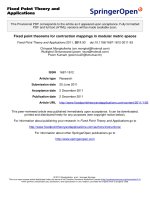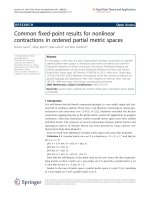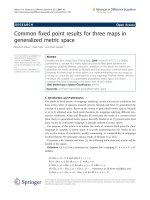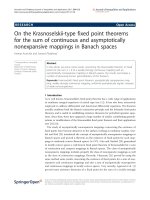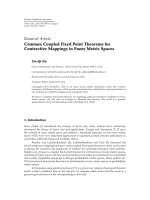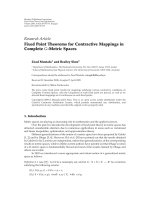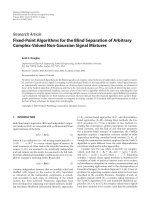fixed point algorithms for inverse problems in science and engineering bauschke, burachik, combettes, elser, luke wolkowicz 2011 06 01 Cấu trúc dữ liệu và giải thuật
Bạn đang xem bản rút gọn của tài liệu. Xem và tải ngay bản đầy đủ của tài liệu tại đây (4.62 MB, 415 trang )
CuuDuongThanCong.com
Fixed-Point Algorithms for Inverse Problems
in Science and Engineering
For further volumes:
/>
CuuDuongThanCong.com
Springer Optimization and Its Applications
VOLUME 49
Managing Editor
Panos M. Pardalos (University of Florida)
Editor–Combinatorial Optimization
Ding-Zhu Du (University of Texas at Dallas)
Advisory Board
J. Birge (University of Chicago)
C.A. Floudas (Princeton University)
F. Giannessi (University of Pisa)
H.D. Sherali (Virginia Polytechnic and State University)
T. Terlaky (McMaster University)
Y. Ye (Stanford University)
Aims and Scope
Optimization has been expanding in all directions at an astonishing rate during the last few decades. New algorithmic and theoretical techniques have
been developed, the diffusion into other disciplines has proceeded at a rapid
pace, and our knowledge of all aspects of the field has grown even more
profound. At the same time, one of the most striking trends in optimization
is the constantly increasing emphasis on the interdisciplinary nature of the
field. Optimization has been a basic tool in all areas of applied mathematics,
engineering, medicine, economics and other sciences.
The series Springer Optimization and Its Applications publishes undergraduate and graduate textbooks, monographs and state-of-the-art expository works that focus on algorithms for solving optimization problems and
also study applications involving such problems. Some of the topics covered include nonlinear optimization (convex and nonconvex), network flow
problems, stochastic optimization, optimal control, discrete optimization,
multi-objective programming, description of software packages, approximation techniques and heuristic approaches.
CuuDuongThanCong.com
Heinz H. Bauschke • Regina S. Burachik
Patrick L. Combettes • Veit Elser
D. Russell Luke • Henry Wolkowicz
Editors
Fixed-Point Algorithms for
Inverse Problems in Science
and Engineering
ABC
CuuDuongThanCong.com
Editors
Heinz H. Bauschke
Department of Mathematics and Statistics
University of British Columbia
Okanagan Campus
Kelowna, British Columbia
Canada
Regina S. Burachik
School of Mathematics & Statistics
Division of Information Technology
Engineering & the Environment
University of South Australia
Mawson Lakes Campus
Mawson Lakes Blvd.
5095 Mawson Lakes
South Australia
Patrick L. Combettes
Universit´e Pierre et Marie Curie
Laboratoire Jacques-Louis Lions
4, Place Jussieu
75005 Paris
France
Veit Elser
Laboratory of Atomic and Solid
State Physics
Cornell University
Clark Hall
14853–2501 Ithaca, New York
USA
D. Russell Luke
Institut f¨ur Numerische und Angewandte
Mathematik
Universit¨at G¨ottingen
Lotzestr. 16-18, 37073 G¨ottingen
Germany
Henry Wolkowicz
Department of Combinatorics
& Optimization
Faculty of Mathematics
University of Waterloo
Waterloo, Ontario
Canada
ISSN 1931-6828
ISBN 978-1-4419-9568-1
e-ISBN 978-1-4419-9569-8
DOI 10.1007/978-1-4419-9569-8
Springer New York Dordrecht Heidelberg London
Library of Congress Control Number: 2011928237
c Springer Science+Business Media, LLC 2011
All rights reserved. This work may not be translated or copied in whole or in part without the written
permission of the publisher (Springer Science+Business Media, LLC, 233 Spring Street, New York,
NY 10013, USA), except for brief excerpts in connection with reviews or scholarly analysis. Use in
connection with any form of information storage and retrieval, electronic adaptation, computer software,
or by similar or dissimilar methodology now known or hereafter developed is forbidden.
The use in this publication of trade names, trademarks, service marks, and similar terms, even if they are
not identified as such, is not to be taken as an expression of opinion as to whether or not they are subject
to proprietary rights.
Printed on acid-free paper
Springer is part of Springer Science+Business Media (www.springer.com)
CuuDuongThanCong.com
Preface
This book brings together 18 carefully refereed research and review papers in the
broad areas of optimization and functional analysis, with a particular emphasis on
topics related to fixed-point algorithms. The volume is a compendium of topics
presented at the Interdisciplinary Workshop on Fixed-Point Algorithms for Inverse
Problems in Science and Engineering, held at the Banff International Research Station for Mathematical Innovation and Discovery (BIRS), on November 1–6, 2009.
Forty experts from around the world were invited. Participants came from Australia,
Austria, Brazil, Bulgaria, Canada, France, Germany, Israel, Japan, New Zealand,
Poland, Spain, and the United States.
Most papers in this volume grew out of talks delivered at this workshop, although
some contributions are from experts who were unable to attend. We believe that the
reader will find this to be a valuable state-of-the-art account on emerging directions
related to first-order fixed-point algorithms.
The editors thank BIRS and their sponsors – Natural Sciences and Engineering
Research Council of Canada (NSERC), US National Science Foundation (NSF),
Alberta Science Research Station (ASRA), and Mexico’s National Council for Science and Technology (CONACYT) – for their financial support in hosting the
workshop, and Wynne Fong, Brent Kearney, and Brenda Williams for their help
in the preparation and realization of the workshop. We are grateful to Dr. Mason
Macklem for his valuable help in the preparation of this volume. Finally, we thank
the dedicated referees who contributed significantly to the quality of this volume
through their instructive and insightful reviews.
Kelowna (Canada)
Adelaide (Australia)
Paris (France)
Ithaca (U.S.A.)
G¨ottingen (Germany)
Waterloo (Canada)
December 2010
Heinz H. Bauschke
Regina S. Burachik
Patrick L. Combettes
Veit Elser
D. Russell Luke
Henry Wolkowicz
v
CuuDuongThanCong.com
CuuDuongThanCong.com
Contents
1
Chebyshev Sets, Klee Sets, and Chebyshev Centers
with Respect to Bregman Distances: Recent Results
and Open Problems . . . . . . . . . . . . . . . . . . . . . . . . . . . . . . . . . . . . . . . . .. . . . . . . . . . . . . . . . .
Heinz H. Bauschke, Mason S. Macklem, and Xianfu Wang
1
2
Self-Dual Smooth Approximations of Convex Functions
via the Proximal Average . . . . . . . . . . . . . . . . . . . . . . . . . . . . . . . . . . .. . . . . . . . . . . . . . . . . 23
Heinz H. Bauschke, Sarah M. Moffat, and Xianfu Wang
3
A Linearly Convergent Algorithm for Solving a Class
of Nonconvex/Affine Feasibility Problems . . . . . . . . . . . . . . . .. . . . . . . . . . . . . . . . . 33
Amir Beck and Marc Teboulle
4
The Newton Bracketing Method for Convex Minimization:
Convergence Analysis . . . . . . . . . . . . . . . . . . . . . . . . . . . . . . . . . . . . . . .. . . . . . . . . . . . . . . . . 49
Adi Ben-Israel and Yuri Levin
5
Entropic Regularization of the 0 Function .. . . . . . . . . . . . . .. . . . . . . . . . . . . . . . . 65
Jonathan M. Borwein and D. Russell Luke
6
The Douglas–Rachford Algorithm in the Absence
of Convexity . . . . . . . . . . . . . . . . . . . . . . . . . . . . . . . . . . . . . . . . . . . . . . . . . .. . . . . . . . . . . . . . . . . 93
Jonathan M. Borwein and Brailey Sims
7
A Comparison of Some Recent Regularity Conditions
for Fenchel Duality . . . . . . . . . . . . . . . . . . . . . . . . . . . . . . . . . . . . . . . . . .. . . . . . . . . . . . . . . . .111
Radu Ioan Bot¸ and Ern¨o Robert Csetnek
8
Non-Local Functionals for Imaging . . . . . . . . . . . . . . . . . . . . . . .. . . . . . . . . . . . . . . . .131
J´erˆome Boulanger, Peter Elbau, Carsten Pontow,
and Otmar Scherzer
vii
CuuDuongThanCong.com
viii
9
Contents
Opial-Type Theorems and the Common Fixed Point
Problem .. . . .. . . . . . . . . . . . . . . . . . . . . . . . . . . . . . . . . . . . . . . . . . . . . . . . . .. . . . . . . . . . . . . . . . .155
Andrzej Cegielski and Yair Censor
10 Proximal Splitting Methods in Signal Processing .. . . . . . .. . . . . . . . . . . . . . . . .185
Patrick L. Combettes and Jean-Christophe Pesquet
11 Arbitrarily Slow Convergence of Sequences of Linear
Operators: A Survey . . . . . . . . . . . . . . . . . . . . . . . . . . . . . . . . . . . . . . . .. . . . . . . . . . . . . . . . .213
Frank Deutsch and Hein Hundal
12 Graph-Matrix Calculus for Computational Convex
Analysis . . . . .. . . . . . . . . . . . . . . . . . . . . . . . . . . . . . . . . . . . . . . . . . . . . . . . . .. . . . . . . . . . . . . . . . .243
Bryan Gardiner and Yves Lucet
13 Identifying Active Manifolds in Regularization Problems . . . . . . . . . . . . . . .261
W.L. Hare
14 Approximation Methods for Nonexpansive Type Mappings
in Hadamard Manifolds . . . . . . . . . . . . . . . . . . . . . . . . . . . . . . . . . . . .. . . . . . . . . . . . . . . . .273
Genaro L´opez and Victoria Mart´ın-M´arquez
15 Existence and Approximation of Fixed Points of Bregman
Firmly Nonexpansive Mappings in Reflexive Banach
Spaces . . . . . . .. . . . . . . . . . . . . . . . . . . . . . . . . . . . . . . . . . . . . . . . . . . . . . . . . .. . . . . . . . . . . . . . . . .301
Simeon Reich and Shoham Sabach
16 Regularization Procedures for Monotone Operators:
Recent Advances .. . . . . . . . . . . . . . . . . . . . . . . . . . . . . . . . . . . . . . . . . . . .. . . . . . . . . . . . . . . . .317
J.P. Revalski
17 Minimizing the Moreau Envelope of Nonsmooth
Convex Functions over the Fixed Point Set of Certain
Quasi-Nonexpansive Mappings . . . . . . . . . . . . . . . . . . . . . . . . . . . .. . . . . . . . . . . . . . . . .345
Isao Yamada, Masahiro Yukawa, and Masao Yamagishi
18 The Br´ezis-Browder Theorem Revisited and Properties
of Fitzpatrick Functions of Order n . . . . . . . . . . . . . . . . . . . . . . .. . . . . . . . . . . . . . . . .391
Liangjin Yao
CuuDuongThanCong.com
Contributors
Heinz H. Bauschke Department of Mathematics, Irving K. Barber School,
University of British Columbia, Kelowna, B.C. V1V 1V7, Canada,
Amir Beck Department of Industrial Engineering, Technion, Israel Institute
of Technology, Haifa 32000, Israel,
Adi Ben-Israel RUTCOR – Rutgers Center for Operations Research, Rutgers
University, 640 Bartholomew Road, Piscataway, NJ 08854-8003, USA,
Jonathan M. Borwein CARMA, School of Mathematical and Physical Sciences,
University of Newcastle, NSW 2308, Australia,
Radu Ioan Bot¸ Faculty of Mathematics, Chemnitz University of Technology,
09107 Chemnitz, Germany,
J´erˆome Boulanger Johann Radon Institute for Computational and Applied
Mathematics, Austrian Academy of Sciences, Altenbergerstraße 69, 4040 Linz,
Austria,
Andrzej Cegielski Faculty of Mathematics, Computer Science and Econometrics,
University of Zielona G´ora, ul. Szafrana 4a, 65-514 Zielona G´ora, Poland,
Yair Censor Department of Mathematics, University of Haifa, Mt. Carmel, Haifa
31905, Israel,
Patrick L. Combettes UPMC Universit´e Paris 06, Laboratoire Jacques-Louis
Lions – UMR CNRS 7598, 75005 Paris, France,
Ern¨o Robert Csetnek Faculty of Mathematics, Chemnitz University of
Technology, 09107 Chemnitz, Germany,
Frank Deutsch Department of Mathematics, Pennsylvania State University,
University Park, PA 16802, USA,
ix
CuuDuongThanCong.com
x
Contributors
Peter Elbau Johann Radon Institute for Computational and Applied Mathematics,
Austrian Academy of Sciences, Altenbergerstraße 69, 4040 Linz, Austria,
Bryan Gardiner Computer Science, I. K. Barber School, University of British
Columbia Okanagan, Kelowna, B.C. V1V 1V7, Canada,
W. L. Hare Department of Mathematics and Statistics, UBC Okanagan Campus,
Kelowna, B.C. V1V 1V7, Canada,
Hein Hundal 146 Cedar Ridge Drive, Port Matilda, PA 16870, USA,
Yuri Levin School of Business, Queen’s University, 143 Union Street, Kingston,
ON K7L 3N6, Canada,
Genaro L´opez Department of Mathematical Analysis, University of Seville,
41012 Seville, Spain,
Yves Lucet Computer Science, I. K. Barber School, University of British
Columbia Okanagan, Kelowna, B.C. V1V 1V7, Canada,
D. Russell Luke Institut f¨ur Numerische und Angewandte Mathematik
Universit¨at G¨ottingen, Lotzestr. 16-18, 37073 G¨ottingen, Germany
Mason S. Macklem Department of Mathematics, Irving K. Barber School,
University of British Columbia, Kelowna, B.C. V1V 1V7, Canada,
Victoria Mart´ın-M´arquez Department of Mathematical Analysis, University of
Seville, 41012 Seville, Spain,
Sarah M. Moffat Department of Mathematics, Irving K. Barber School,
University of British Columbia, Kelowna, B.C. V1V 1V7, Canada,
J.-C. Pesquet Laboratoire d’Informatique Gaspard Monge, UMR CNRS 8049,
Universit´e Paris-Est, 77454 Marne la Vall´ee Cedex 2, France,
Carsten Pontow Department of Mathematics, University Innsbruck, Technikerstr.
21a, 6020 Innsbruck, Austria,
Simeon Reich Department of Mathematics, The Technion – Israel Institute of
Technology, 32000 Haifa, Israel,
J.P. Revalski Institute of Mathematics and Informatics, Bulgarian Academy of
Sciences, Acad. G. Bonchev Street, block 8, 1113 Sofia, Bulgaria,
Shoham Sabach Department of Mathematics, The Technion – Israel Institute of
Technology, 32000 Haifa, Israel,
CuuDuongThanCong.com
Contributors
xi
Otmar Scherzer Computational Science Center, University Vienna, Nordbergstr.
15, 1090 Vienna, Austria, and Johann Radon Institute for Computational and
Applied Mathematics, Austrian Academy of Sciences, Altenbergerstraße 69,
4040 Linz, Austria,
Brailey Sims CARMA, School of Mathematical and Physical Sciences, University
of Newcastle, NSW 2308, Australia,
Marc Teboulle School of Mathematical Sciences, Tel Aviv University, Tel Aviv
69978, Israel,
Xianfu Wang Department of Mathematics, Irving K. Barber School, University
of British Columbia, Kelowna, B.C. V1V 1V7, Canada,
Isao Yamada Department of Communications and Integrated Systems, Tokyo
Institute of Technology, S3-60, Tokyo, 152-8550 Japan,
Masao Yamagishi Department of Communications and Integrated Systems,
Tokyo Institute of Technology, S3-60, Tokyo, 152-8550 Japan,
Liangjin Yao Department of Mathematics, Irving K. Barber School, University of
British Columbia, Kelowna, B.C. V1V 1V7, Canada,
Masahiro Yukawa Department of Electrical and Electronic Engineering,
Niigata University, 8050 Ikarashi Nino-cho, Nishi-ku, Niigata, 950-2181 Japan,
CuuDuongThanCong.com
CuuDuongThanCong.com
Chapter 1
Chebyshev Sets, Klee Sets, and Chebyshev
Centers with Respect to Bregman Distances:
Recent Results and Open Problems
Heinz H. Bauschke, Mason S. Macklem, and Xianfu Wang
Abstract In Euclidean spaces, the geometric notions of nearest-points map,
farthest-points map, Chebyshev set, Klee set, and Chebyshev center are well known
and well understood. Since early works going back to the 1930s, tremendous theoretical progress has been made, mostly by extending classical results from Euclidean
space to Banach space settings. In all these results, the distance between points is
induced by some underlying norm. Recently, these notions have been revisited
from a different viewpoint in which the discrepancy between points is measured
by Bregman distances induced by Legendre functions. The associated framework
covers the well known Kullback–Leibler divergence and the Itakura–Saito distance.
In this survey, we review known results and we present new results on Klee sets
and Chebyshev centers with respect to Bregman distances. Examples are provided
and connections to recent work on Chebyshev functions are made. We also identify
several intriguing open problems.
Keywords Bregman distance · Chebyshev center · Chebyshev function
· Chebyshev point of a function · Chebyshev set · Convex function · Farthest
point · Fenchel conjugate · Itakura–Saito distance · Klee set · Klee function
· Kullback–Leibler divergence · Legendre function · Nearest point · Projection
AMS 2010 Subject Classification: Primary 41A65; Secondary 28D05, 41A50,
46N10, 47N10, 49J53, 54E52, 58C06, 90C25
H.H. Bauschke ( )
Department of Mathematics, Irving K. Barber School, University of British Columbia,
Kelowna, B.C. V1V 1V7, Canada
e-mail:
H.H. Bauschke et al. (eds.), Fixed-Point Algorithms for Inverse Problems in Science
and Engineering, Springer Optimization and Its Applications 49,
DOI 10.1007/978-1-4419-9569-8 1, c Springer Science+Business Media, LLC 2011
CuuDuongThanCong.com
1
2
H.H. Bauschke et al.
1.1 Introduction
1.1.1 Legendre Functions and Bregman Distances
Throughout, we assume that
X = Rn is the standard Euclidean space with inner product ·, · ,
(1.1)
x, x , and with metric (x, y) → x − y . In addition,
with induced norm · : x →
it is assumed that
f : X → ]−∞, +∞] is a convex function of Legendre type,
(1.2)
also referred to as a Legendre function. We assume the reader is familiar with basic
results and standard notation from Convex Analysis; see, e.g., [33, 34, 40]. In particular, f ∗ denotes the Fenchel conjugate of f , and intdom f is the interior of the
domain of f . For a subset C of X, C stands for the closure of C, convC for the convex hull of C, and ιC for the indicator function of C, i.e., ιC (x) = 0, if x ∈ C and
ιC (x) = +∞, if x ∈ X C. Now set
U = int dom f .
(1.3)
Example 1.1 (Legendre functions). The following are Legendre functions,1 each
evaluated at a point x ∈ X.
(i) Halved energy: f (x) =
1
2
x
(ii) Negative entropy: f (x) =
(iii) Negative logarithm: f (x) =
Note that U
= Rn
2
=
j
1
2
2
j xj.
x j ln(x j ) − x j , if x ≥ 0;
+∞,
otherwise.
j ln(x j ),
−
+∞,
inss (i), whereas U
= Rn++
if x > 0;
otherwise.
in (ii) and (iii).
Further examples of Legendre functions can be found in, e.g., [2, 5, 12, 33].
1
Here and elsewhere, inequalities between vectors in Rn are interpreted coordinate-wise.
CuuDuongThanCong.com
1
Chebyshev Sets, Klee Sets, and Chebyshev Centers
3
Fact 1.2 (Rockafellar). (See [33, Theorem 26.5].) The gradient map ∇ f is a
continuous bijection between int dom f and int dom f ∗ , with continuous inverse map
(∇ f )−1 = ∇ f ∗ . Furthermore, f ∗ is also a convex function of Legendre type.
Given x ∈ U and C ⊆ U, it will be convenient to write
x∗ = ∇ f (x),
(1.4)
∗
C = ∇ f (C),
(1.5)
U ∗ = int dom f ∗ ,
(1.6)
and similarly for other vectors and sets in U. Note that we used Fact 1.2 for (1.6).
While the Bregman distance defined next is not a distance in the sense of metric
topology, it does possess some good properties that allow it to measure the discrepancy between points in U.
Definition 1.3 (Bregman distance). (See [13, 15, 16].) The Bregman distance
with respect to f , written D f or simply D, is the function
D : X × X → [0, +∞] : (x, y) →
f (x) − f (y) − ∇ f (y), x − y , if y ∈ U;
+∞,
otherwise.
(1.7)
Fact 1.4. (See [2, Proposition 3.2(i) and Theorem 3.7(iv) and (v)].) Let x and y be
in U. Then the following hold:
(i) D f (x, y) = f (x) + f ∗ (y∗ ) − y∗ , x = D f ∗ (y∗ , x∗ ).
(ii) D f (x, y) = 0 ⇔ x = y ⇔ x∗ = y∗ ⇔ D f ∗ (x∗ , y∗ ) = 0.
Example 1.5. The Bregman distances corresponding to the Legendre functions of
Example 1.1 between two points x and y in X are as follows:
(i) D(x, y) =
(ii) D(x, y) =
(iii) D(x, y) =
1
2
x − y 2.
j
+∞,
j
+∞,
x j ln(x j /y j ) − x j + y j , if x ≥ 0 and y > 0;
otherwise.
ln(y j /x j ) + x j /y j − 1 , if x > 0 and y > 0;
otherwise.
These Bregman distances are also known as (i) the halved Euclidean distance
squared, (ii) the Kullback–Leibler divergence, and (iii) the Itakura–Saito distance,
respectively.
CuuDuongThanCong.com
4
H.H. Bauschke et al.
From now on, we assume that C is a subset of X such that
C is closed and ∅ = C ⊆ U.
(1.8)
The power set (the set of all subsets) of C is denoted by 2C .
We are now in a position to introduce the various geometric notions.
1.1.2 Nearest Distance, Nearest Points, and Chebyshev Sets
Definition 1.6 (Bregman nearest-distance function and nearest-points map).
The left Bregman nearest-distance function with respect to C is
←
−
DC : X → [0, +∞] : y → inf D(x, y),
x∈C
(1.9)
and the left Bregman nearest-points map2 with respect to C is
←
−
←
−
PC : X → 2C : y → x ∈ C D(x, y) = DC (y) < +∞ .
(1.10)
The right Bregman nearest-distance and the right Bregman nearest-point map with
respect to C are
→
−
(1.11)
DC : X → [0, +∞] : x → inf D(x, y)
y∈C
and
−
→
→
−
P C : X → 2C : x → y ∈ C D(x, y) = DC (x) < +∞ ,
(1.12)
respectively. If we need to emphasize the underlying Legendre function f , then we
− −
→
→
−
←
− ←
write D f ,C , P f ,C , D f ,C , and P f ,C .
Definition 1.7 (Chebyshev sets). The set C is a left Chebyshev set with respect
←
−
←
−
to the Bregman distance, or simply D-Chebyshev, if for every y ∈ U, PC (y) is a
singleton. Similarly, the set C is a right Chebyshev set with respect to the Bregman
→
−
→
−
distance, or simply D-Chebyshev, if for every x ∈ U, P C (x) is a singleton.
Remark 1.8 (Classical Bunt-Motzkin result). Assume that f is the halved energy as
in Example 1.1(i). Since the halved Euclidean distance squared (see Example 1.5(i))
is symmetric, the left and right (Bregman) nearest distances coincide, as do the
corresponding nearest-point maps. Furthermore, the set C is Chebyshev if and only
2
This operator, which has turned out to be quite useful in Optimization and which has found many
applications (for a recent one, see [32]), is often referred to as the Bregman projection.
CuuDuongThanCong.com
1
Chebyshev Sets, Klee Sets, and Chebyshev Centers
5
if for every z ∈ X, the metric3 projection PC (z) is a singleton. It is well known that
if C is convex, then C is Chebyshev. In the mid-1930s, Bunt [14] and Motzkin [28]
showed independently that the following converse holds:
C is Chebyshev =⇒ C is convex.
(1.13)
For other works in this direction, see, e.g., [1, 9–11, 17, 22, 24, 25, 35–37]. It is still
unknown whether or not (1.13) holds in general Hilbert spaces. We review corresponding results for the present Bregman setting in Sect. 1.3.
1.1.3 Farthest Distance, Farthest Points, and Klee Sets
Definition 1.9 (Bregman farthest-distance function and farthest-points map).
The left Bregman farthest-distance function with respect to C is
←
−
F C : X → [0, +∞] : y → sup D(x, y),
(1.14)
x∈C
and the left Bregman farthest-points map with respect to C is
←
−
←
−
QC : X → 2C : y → x ∈ C D(x, y) = FC (y) < +∞ .
(1.15)
Similarly, the right Bregman farthest-distance function with respect to C is
−
→
F C : X → [0, +∞] : x → sup D(x, y),
(1.16)
y∈C
and the right Bregman farthest-points map with respect to C is
−
→
→
−
QC : X → 2C : x → y ∈ C D(x, y) = F C (x) < +∞ .
(1.17)
←
−
If we need to emphasize the underlying Legendre function f , then we write F f ,C ,
→
−
←
− −
→
Q f ,C , F f ,C , and Q f ,C .
Definition 1.10 (Klee sets). The set C is a left Klee set with respect to the Bregman
←
−
←
−
distance, or simply D-Klee, if for every y ∈ U, QC (y) is a singleton. Similarly,
the set C is a right Klee set with respect to the right Bregman distance, or simply
→
−
→
−
D-Klee, if for every x ∈ U, QC (x) is a singleton.
Remark 1.11 (Classical Klee result). Assume again that f is the halved energy as
in Example 1.1(i). Then the left and right (Bregman) farthest-distance functions
3
The metric projection is the nearest-points map with respect to the Euclidean distance.
CuuDuongThanCong.com
6
H.H. Bauschke et al.
coincide, as do the corresponding farthest-points maps. Furthermore, the set C is
Klee if and only if for every z ∈ X, the metric farthest-points map QC (z) is a
singleton. It is obvious that if C is a singleton, then C is Klee. In 1961, Klee [27]
showed the following converse:
C is Klee =⇒ C is a singleton.
(1.18)
See, e.g., also [1,11,17,23–25,29,39]. Once again, it is still unknown whether or not
(1.18) remains true in general Hilbert spaces. The present Bregman-distance setting
is reviewed in Sect. 1.4.
1.1.4 Chebyshev Radius and Chebyshev Center
←
−
Definition 1.12 (Chebyshev radius and Chebyshev center). The left D-Chebyshev radius of C is
←
−
←
−
(1.19)
r C = inf FC (y)
y∈U
←
−
and the left D-Chebyshev center of C is
←
−
←
−
−
Z C = y ∈ U F C (y) = ←
r C < +∞ .
(1.20)
→
−
Similarly, the right D-Chebyshev radius of C is
→
−r = inf −
→
F C (x)
C
x∈U
(1.21)
→
−
and the right D-Chebyshev center of C is
−
→
−
→
→
r C < +∞ .
Z C = x ∈ U F C (x) = −
(1.22)
−
If we need to emphasize the underlying Legendre function f , then we write ←
r f ,C ,
←
− −
→
−
→
Z f ,C , r f ,C , and Z f ,C .
Remark 1.13 (Classical Garkavi-Klee result). Again, assume that f is the halved
energy as in Example 1.1(i) so that the left and right (Bregman) farthest-distance
functions coincide, as do the corresponding farthest-points maps. Furthermore, assume that C is bounded. In the 1960s, Garkavi [19] and Klee [26] proved that the
Chebyshev center is a singleton, say {z}, which is characterized by
z ∈ convQC (z).
(1.23)
See also [30, 31] and Sect. 1.5. In passing, we note that Chebyshev centers are also
utilized in Fixed Point Theory; see, e.g., [20, Chap. 4].
CuuDuongThanCong.com
1
Chebyshev Sets, Klee Sets, and Chebyshev Centers
7
1.1.5 Goal of the Paper
The aim of this survey is threefold. First, we review recent results concerning Chebyshev sets, Klee sets, and Chebyshev centers with respect to Bregman
distances. Second, we provide some new results and examples on Klee sets and
Chebyshev centers. Third, we formulate various tantalizing open problems on these
notions as well as on the related concepts of Chebyshev functions.
1.1.6 Organization of the Paper
The remainder of the paper is organized as follows. In Sect. 1.2, we record auxiliary
results which will make the derivation of the main results more structured. Chebyshev sets and corresponding open problems are discussed in Sect. 1.3. In Sect. 1.4,
we review results and open problems for Klee sets, and we also present a new result (Theorem 1.27) concerning left Klee sets. Chebyshev centers are considered
in Sect. 1.5, where we also provide a characterization of left Chebyshev centers
(Theorem 1.31). Chebyshev centers are illustrated by two examples in Sect. 1.6. Recent related results on variations of Chebyshev sets and Klee sets are considered in
Sect. 1.7. Along our journey, we pose several questions that we list collectively in
the final Sect. 1.8.
1.2 Auxiliary Results
For the reader’s convenience, we present the following two results which are implicitly contained in [6] and [7].
Lemma 1.14. Let x and y be in C. Then the following hold:
→
−
→
−
←
−
←
−
(i) D f ,C (y) = D f ∗ ,C∗ (y∗ ) and D f ,C (x) = D f ∗ ,C∗ (x∗ ).
←
−
→
−
→
−
←
−
(ii) P f ,C U = ∇ f ∗ ◦ P f ∗ ,C∗ ◦ ∇ f and P f ,C U = ∇ f ∗ ◦ P f ∗ ,C∗ ◦ ∇ f .
→
−
→
−
←
−
←
−
(iii) P f ∗ ,C∗ U ∗ = ∇ f ◦ P f ,C ◦ ∇ f ∗ and P f ∗ ,C∗ U ∗ = ∇ f ◦ P f ,C ◦ ∇ f ∗ .
Proof. This follows from Fact 1.2, Fact 1.4(i), and Definition 1.6. (See also
[6, Proposition 7.1].)
Lemma 1.15. Let x and y be in C. Then the following hold:
←
−
→
−
→
−
←
−
(i) F f ,C (y) = F f ∗ ,C∗ (y∗ ) and F f ,C (x) = F f ∗ ,C∗ (x∗ ).
←
−
→
−
→
−
←
−
(ii) Q f ,C U = ∇ f ∗ ◦ Q f ∗ ,C∗ ◦ ∇ f and Q f ,C U = ∇ f ∗ ◦ Q f ∗ ,C∗ ◦ ∇ f .
→
−
→
−
←
−
←
−
(iii) Q f ∗ ,C∗ U ∗ = ∇ f ◦ Q f ,C ◦ ∇ f ∗ and Q f ∗ ,C∗ U ∗ = ∇ f ◦ Q f ,C ◦ ∇ f ∗ .
CuuDuongThanCong.com
8
H.H. Bauschke et al.
Proof. This follows from Fact 1.2, Fact 1.4(i), and Definition 1.9. (See also
[7, Proposition 7.1].)
The next observation on the duality of Chebyshev radii and Chebyshev centers
is new.
Lemma 1.16. The following hold:
−
→
→
−
(i) ←
r f ,C = −
r f ∗ ,C∗ and −
r f ,C = ←
r f ∗ ,C∗ .
→
−
→
−
←
−
←
−
∗
(ii) Z f ,C = ∇ f Z f ∗ ,C∗ and Z f ,C = ∇ f ∗ Z f ∗ ,C∗ .
←
−
→
−
←
−
→
−
(iii) Z f ∗ ,C∗ = ∇ f Z f ,C and Z f ∗ ,C∗ = ∇ f Z f ,C .
←
−
→
−
(iv) Z f ,C is a singleton ⇔ Z f ∗ ,C∗ is a singleton.
←
−
→
−
(v) Z f ,C is a singleton ⇔ Z f ∗ ,C∗ is a singleton.
Proof. (i): Using Definition 1.12 and Lemma 1.15(i), we see that
←
−
→
−
←
−
→
r f ,C = inf F C (y) = ∗inf ∗ F C∗ (y∗ ) = −
r f ∗ ,C∗
(1.24)
→
−
←
−
←
−
−r
→
∗
f ,C = inf F C (y) = ∗inf ∗ F C∗ (y ) = r f ∗ ,C∗ .
(1.25)
y∈U
and that
y∈U
y ∈U
y ∈U
(ii) and (iii): Let z ∈ U. Using (i) and Lemma 1.15(i), we see that
←
−
→
−
→
−
←
−
−
→
r f ,C ⇔ F f ∗ ,C∗ (z∗ ) = −
r f ∗ ,C∗ ⇔ z∗ ∈ Z f ∗ ,C∗ .
z ∈ Z f ,C ⇔ F f ,C (z) = ←
(1.26)
→
−
→
−
←
−
←
−
This verifies Z f ,C = ∇ f ∗ Z f ∗ ,C∗ and Z f ∗ ,C∗ = ∇ f Z f ,C . The remaining identities follow similarly.
(iv) and (v): Clear from (ii) and (iii) and Fact 1.2.
The following two results play a key role for studying the single-valuedness of
→
−
←
−
−
→
←
−
P f ,C via P f ∗ ,C∗ and Q f ,C via Q f ∗ ,C∗ by duality.
Lemma 1.17. Let V and W be nonempty open subsets of X, and let T : V → W
be a homeomorphism, i.e., T is a bijection and both T and T −1 are continuous.
Furthermore, let G be a residual4 subset of V . Then T (G) is a residual subset of W .
Proof. As G is residual, there exist sequence of dense open subsets (Ok )k∈N of V
such that G ⊇ k∈N Ok . Then T (G) ⊇ T ( k∈N Ok ) = k∈N T (Ok ). Since T : V → W
is a homeomorphism and each Ok is dense in V , we see that each T (Ok ) is open and
dense in W . Therefore, k∈N T (Ok ) is a dense Gδ subset in W .
Lemma 1.18. Let V be a nonempty open subset of X, and let T : V → Rn be locally
Lipschitz. Furthermore, let S be a subset of V that has Lebesgue measure zero. Then,
T (S) has Lebesgue measure zero as well.
4
Also known as “second category”.
CuuDuongThanCong.com
1
Chebyshev Sets, Klee Sets, and Chebyshev Centers
9
Proof. Denote the closed unit ball in X by B. For every y ∈ V , let r(y) > 0 be such
that T is Lipschitz continuous with constant c(y) on the open ball O(y) centered at
y of radius r(y). In this proof, we denote the Lebesgue measure by λ . Let K be a
compact subset of X. To show that T (S) has Lebesgue measure zero, it suffices to
show that λ (T (K ∩ S)) = 0 because
λ T (S) = λ T
S ∩ kB
λ T (S ∩ kB) .
≤
k∈N
(1.27)
k∈N
The Heine–Borel theorem provides a finite subset {y1 , . . . , ym } of V such that
m
O(y j ).
K⊆
(1.28)
j=1
We now proceed using a technique implicit in the proof of [21, Corollary 1]. Set
c = max{c1 , c2 , . . . , cm }. Given ε > 0, there exists an open subset G of X such that
G ⊇ K ∩ S and λ (G) < ε . For each y ∈ K ∩ S, let Q(y) be an open cubic interval
centered at y of semi-edge length s(y) > 0 such that
(∃ j ∈ {1, . . . , m}) Q(y) ⊆ G ∩ O(y j ).
(1.29)
Then for each x ∈ Q(y), we have
√
T x − Ty ≤ c x − y ≤ c ns(y).
(1.30)
Hence, the image of Q(y) by T , T (Q(y)), is contained in a cubic
√ interval – which we
denote by Q∗ (Ty) – of center Ty and with semi-edge length c ns(y). Applying the
Besicovitch Covering Theorem, we see that there exists a sequence (Qk )k∈N chosen
among the open covering (Q(y))y∈K∩S such that
K ∩S ⊆
Qk
χQk ≤ θ ,
and
k∈N
(1.31)
k∈N
where χQk stands for the characteristic function of Qk and where the constant θ only
depends on the dimension of X. Thus,
Qk =
T (K ∩ S) ⊆ T
k∈N
Q∗k .
T (Qk ) ⊆
k∈N
(1.32)
k∈N
√
Now set d = (c n)n so that λ (Q∗k ) ≤ d λ (Qk ). Then, using (1.29) and (1.31), we
see that
λ ∪k∈N Q∗k ≤
λ (Q∗k ) ≤ d
k∈N
λ (Qk ) = d
k∈N
χQk = d
k∈N
χQk
k∈N
≤ d θ λ (G)
≤ dθ ε.
Since ε was chosen arbitrarily, we conclude that λ (T (K ∩ S)) = 0.
CuuDuongThanCong.com
(1.33)
10
H.H. Bauschke et al.
Alternatively, one may argue as follows starting from (1.28). We have K ∩ S ⊆
m
m
j=1 O(y j ) ∩ S =
j=1 O(y j ) ∩ S so that
m
T (K ∩ S) ⊆
T (O(y j ) ∩ S).
(1.34)
j=1
Since T is Lipschitz on each O(y j ) with constant c(y j ) and since λ (O(y j ) ∩ S) = 0,
we apply [18, Proposition 262D, page 286] and conclude that λ (T (O(y j ) ∩ S)) = 0.
Therefore, λ (T (K ∩ S)) = 0 by (1.34).
1.3 Chebyshev Sets
We start by reviewing the strongest known results concerning left and right Chebyshev sets with respect to Bregman distances.
←
−
Fact 1.19 ( D-Chebyshev sets). (See [6, Theorem 4.7].) Suppose that f is super←
−
coercive5 and that C is D-Chebyshev. Then C is convex.
→
−
Fact 1.20 ( D-Chebyshev sets). (See [6, Theorem 7.3].) Suppose that dom f = X,
→
−
that C∗ ⊆ U ∗ , and that C is D-Chebyshev. Then C∗ is convex.
It is not known whether or not Fact 1.19 and 1.20 are the best possible results.
For instance, is the assumption on supercoercivity in Fact 1.19 really necessarily?
Similarly, do we really require full domain of f in Fact 1.20?
Example 1.21. (See [6, Example 7.5].) Suppose that X = R2 , that f is the negative
entropy (see Example 1.1(ii)), and that
C = (eλ , e2λ ) λ ∈ [0, 1] .
(1.35)
→
−
Then f is supercoercive and C is a nonconvex D-Chebyshev set.
Example 1.21 is somewhat curious – not only does it illustrate that the rightChebyshev-set counterpart of Fact 1.19 fails but it also shows that the conclusion of
Fact 1.20 may hold even though f is not assumed to have full domain.
Fact 1.22. (See [4, Lemma 3.5].) Suppose that f is the negative entropy (see
→
−
Example 1.1(ii)) and that C is convex. Then C is D-Chebyshev.
5
By [2, Proposition 2.16] and [33, Corollary 14.2.2], f is supercoercive ⇔
dom
f∗
= X ⇒ 0 ∈ int dom
CuuDuongThanCong.com
f∗
⇔
lim
x →+∞
f (x) = +∞ ⇔ f is coercive.
lim
x →+∞
f (x)
x
= +∞ ⇔
1
Chebyshev Sets, Klee Sets, and Chebyshev Centers
11
Fact 1.22 raises two intriguing questions. Apart from the case of quadratic functions, are there instances of f , where f has full domain and where every closed
→
−
convex subset of U is D-Chebyshev? Because of Fact 1.20, an affirmative answer to this question would imply that ∇ f is a (quite surprising) nonaffine yet
convexity-preserving transformation. Combining Example 1.21 and Fact 1.22, we
deduce that – when working with the negative entropy – if C is convex, then C is
→
−
→
−
D-Chebyshev but not vice versa. Is it possible to describe the D-Chebyshev sets in
this setting?
←
−
We also note that C is “nearly D-Chebyshev” in the following sense.
Fact 1.23. (See [6, Corollary 5.6].) Suppose that f is supercoercive, that f is twice
continuously differentiable, and that for every y ∈ U, ∇2 f (y) is positive definite.
←
−
Then, PC is almost everywhere and generically6 single-valued on U.
It would be interesting to see whether or not supercoercivity is essential in
Fact 1.23. By duality, we obtain the following result on the single-valuedness
→
−
of P f ,C .
Corollary 1.24. Suppose that f has full domain, that f ∗ is twice continuously dif→
−
ferentiable, and that ∇2 f ∗ (y) is positive definite for every y ∈ U ∗ . Then, P f ,C is
almost everywhere and generically single-valued on U.
→
−
←
−
←
−
Proof. By Lemma 1.14(ii), P f ,C U = ∇ f ∗ ◦ P f ∗ ,C∗ ◦ ∇ f . Fact 1.23 states that P f ∗ ,C∗
is almost everywhere and generically single-valued on U ∗ . Since f ∗ is twice continuously differentiable, it follows from the Mean Value Theorem that ∇ f ∗ is locally
Lipschitz. Since (∇ f )−1 = ∇ f ∗ is a locally Lipschitz homeomorphism from U ∗ to
U, the conclusion follows from Lemmas 1.17 and 1.18.
1.4 Klee Sets
Previously known were the following two results:
←
−
Fact 1.25 ( D-Klee sets). (See [7, Theorem 4.4].) Suppose that f is supercoercive,
←
−
that C is bounded, and that C is D-Klee. Then C is a singleton.
→
−
Fact 1.26 ( D-Klee sets). (See [8, Theorem 3.2].) Suppose that C is bounded and
→
−
that C is D-Klee. Then C is a singleton.
Fact 1.25 immediately raises the question whether or not supercoercivity is really
an essential hypothesis. Fortunately, thanks to Fact 1.26, which was recently proved
for general Legendre functions without any further assumptions, we are now able to
present a new result which removes the supercoercivity assumption in Fact 1.25.
←
−
That is, the set S of points y ∈ U where PC (y) is not a singleton is very small both in measure
theory (S has measure 0) and in category theory (S is meager/first category).
6
CuuDuongThanCong.com
12
H.H. Bauschke et al.
←
−
Theorem 1.27 ( D-Klee sets revisited). Suppose that C is bounded and that C is
←
−
D-Klee. Then C is a singleton.
Proof. On the one hand, since C is compact, Fact 1.2 implies that C∗ is compact.
→
−
On the other hand, by Lemma 1.15(iii), the set C∗ is D f ∗ -Klee. Altogether, we
∗
∗
∗
deduce from Fact 1.26 (applied to f and C ) that C is a singleton. Therefore, C is
a singleton by Fact 1.2.
←
−
Similarly to the setting of Chebyshev sets, the set C is “nearly D-Klee” in the
following sense.
Fact 1.28. (See [6, Corollary 5.2(ii)].) Suppose that f is supercoercive, f is twice
continuously differentiable, for every y ∈ U, ∇2 f (y) is positive definite, and that C
←
−
is bounded. Then, QC is almost everywhere and generically single-valued on U.
Again, it would be interesting to see whether or not supercoercivity is essential
in Fact 1.28. Similarly to the proof of Corollary 1.24, we obtain the following result
→
−
on the single-valuedness of Q f ,C .
Corollary 1.29. Suppose that f has full domain, f ∗ is twice continuously differen→
−
tiable, ∇2 f ∗ (y) is positive definite for every y ∈ U ∗ , and C is bounded. Then, Q f ,C
is almost everywhere and generically single-valued on U.
1.5 Chebyshev Centers: Uniqueness and Characterization
→
−
Fact 1.30 ( D-Chebyshev centers). (See [8, Theorem 4.4].) Suppose that C is
bounded. Then the right Chebyshev center with respect to C is a singleton, say
→
−
Z C = {x}, and x is characterized by
→
−
x ∈ ∇ f ∗ conv∇ f ( QC (x)) .
(1.36)
We now present a corresponding new result on the left Chebyshev center.
←
−
Theorem 1.31 ( D-Chebyshev centers). Suppose that C is bounded. Then the left
←
−
Chebyshev center with respect to C is a singleton, say Z C = {y}, and y is characterized by
←
−
(1.37)
y ∈ conv QC (y).
Proof. By Lemma 1.16(ii),
←
−
→
−
Z f ,C = ∇ f ∗ Z f ∗ ,C∗ .
(1.38)
Now, C∗ is a bounded subset of U ∗ because of the compactness of C and Fact 1.2.
→
−
Applying Fact 1.30 to f ∗ and C∗ , we obtain that Z f ∗ ,C∗ = {y∗ } for some y∗ ∈ U ∗
∗
and that y is characterized by
CuuDuongThanCong.com


